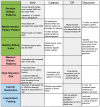Dietary Patterns, Carbohydrates, and Age-Related Eye Diseases
- PMID: 32962100
- PMCID: PMC7551870
- DOI: 10.3390/nu12092862
Dietary Patterns, Carbohydrates, and Age-Related Eye Diseases
Abstract
Over a third of older adults in the U.S. experience significant vision loss, which decreases independence and is a biomarker of decreased health span. As the global aging population is expanding, it is imperative to uncover strategies to increase health span and reduce the economic burden of this age-related disease. While there are some treatments available for age-related vision loss, such as surgical removal of cataracts, many causes of vision loss, such as dry age-related macular degeneration (AMD), remain poorly understood and no treatments are currently available. Therefore, it is necessary to better understand the factors that contribute to disease progression for age-related vision loss and to uncover methods for disease prevention. One such factor is the effect of diet on ocular diseases. There are many reviews regarding micronutrients and their effect on eye health. Here, we discuss the impact of dietary patterns on the incidence and progression of age-related eye diseases, namely AMD, cataracts, diabetic retinopathy, and glaucoma. Then, we focus on the specific role of dietary carbohydrates, first by outlining the physiological effects of carbohydrates on the body and then how these changes translate into eye and age-related ocular diseases. Finally, we discuss future directions of nutrition research as it relates to aging and vision loss, with a discussion of caloric restriction, intermittent fasting, drug interventions, and emerging randomized clinical trials. This is a rich field with the capacity to improve life quality for millions of people so they may live with clear vision for longer and avoid the high cost of vision-saving surgeries.
Keywords: Mediterranean diet; age-related macular degeneration; caloric restriction; cataract; diabetic retinopathy; dietary pattern; glaucoma; glycemic index; intermittent fasting.
Conflict of interest statement
The authors declare no conflict of interest. The funders had no role in the writing of the manuscript, or in the decision to publish the results.
Figures


References
-
- Wong W.L., Su X., Li X., Cheung C.M., Klein R., Cheng C.Y., Wong T.Y. Global prevalence of age-related macular degeneration and disease burden projection for 2020 and 2040: A systematic review and meta-analysis. Lancet Glob. Health. 2014;2:e106–e116. doi: 10.1016/S2214-109X(13)70145-1. - DOI - PubMed
-
- World Health Organization Blindness and Vision Impairment. [(accessed on 4 June 2020)]; Available online: https://www.who.int/news-room/fact-sheets/detail/blindness-and-visual-im....
-
- World Health Organization . World Report on Vision. WHO Press; Geneva, Switzerland: 2019.
-
- Chew E.Y., Clemons T.E., SanGiovanni J.P., Danis R., Ferris F.L., Elman M., Antoszyk A., Ruby A., Orth D., Bressler S. Lutein + zeaxanthin and omega-3 fatty acids for age-related macular degeneration: The Age-Related Eye Disease Study 2 (AREDS2) randomized clinical trial. JAMA. 2013;309:2005–2015. - PubMed
Publication types
MeSH terms
Substances
Grants and funding
LinkOut - more resources
Full Text Sources
Medical
Research Materials

